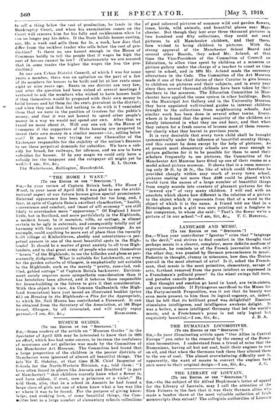MUSEUM GUIDES.
[To THE EDITOR OF THE " SPECTATOR.") STS,—Some readers of the article on "Museum Guides" in the Spectator of April 12th may be interested to know that in 1895 an effort, which has had some success, to increase the usefulness of museums and art galleries was made by the Committee of the Manchester Art Museum. The Committee had found that a large proportion of the children in the poorer districts of Manchester were ignorant of almost all beautiful things. The late 'Sir E. Oak-eley, at that time H.M. Chief Inspector of Schools for the North-Western Division, e.g., told them "I hare often found in places like Ancoats and Bradford " (a part at Manchester) " that children scarcely know what a flower is, and hare seldom, if ever, seen a primrose or a violet." He told them, also, that in a school in Ancoats he had found a large class of girls not one of whom knew what a bee was like or where it was to be found. For the purpose of giving know- ledge, and evoking love, of some beautiful things. the Com- mittee lent to a large number of elementary schools collections of good coloured pictures of common wild and garden flowers, trees, birds, wild animals, and beautiful places near Man- chester. But though they lent over three thousand pictures in two hundred and fifty collections, they could not send pictures to all Manchester children, and they . there- fore wished to bring children to pictures. With the strong approval of the Manchester School Board and several other Boards, they asked Mr. Acland, at that time the Vice-President of the Committee of Council on Education, to allow time spent by children at a museum or picture gallery under the charge of a teacher to count as time spent in school, and in 1895 Mr. Arland made the necessary alterations in the Code. The Committee of the Art Museum meek it one of the chief duties of their Curator to give lessons to children on pictures and their subjects, and in every year since then several thousand children have been taken by their teachers to the museum. The Education Committee in Man- chester have applied the same system in other buildings. Both in the Municipal Art Gallery and in the University Museum they have appointed well-trained guides to interest children brought to the collections from neighbouring schools. And similar work has been done in several other towns. Every- where it is found that the great majority of the children are keenly interested in what they see and hear, and that when they return for a fresh course of lessons most of them remem- ber clearly what they learnt in previous yeara.
It is very desirable that every town child shall be brought systematically under the influence of beautiful country things, and this cannot be done except by the help of pictures. As at present most elementary schools are not near enough to picture galleries for it to be possible for them to send their scholars frequently to see pictures, the Committee of the Manchester Art Museum have fitted up one of their rooms as a model school picture museum. It shows that in a room measur- ing only 30 ft. by 20 ft., the like of which could therefore be provided cheaply within easy reach of every town school, pictures costing not more than £100 could be placed which would turn the names of a large number of beautiful things from empty sounds into creators of pleasant pictures for the "inward eye" of very many children. I will end with an anecdote which shows how different is the relation of a picture to the object which it represents from that of a word to the object of which it is the name. A friend told me that in a Birmingham park a girl was seen pointing out a foxglove to her companion, to whom she said: "That's the flower we've a picture of in our school."—I am, Sir, &c., T. C. Honsrsth.


































 Previous page
Previous page